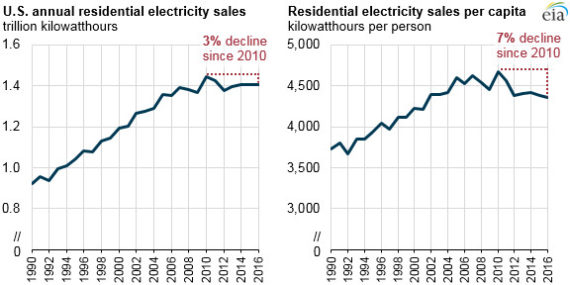Above Photo: From Mike Alewitz
Recently, SCANA Corporation, a major utility company in South Carolina, announced it is suspending construction on two nuclear power plants. Part of the problem was spiraling costs to complete the project. But another equally important reason was that the demand for electricity has not increased the way planners expected when the project was first proposed in 2008. That’s not surprising. A new report reveals that demand for electricity in US homes all across America is down from what it was 10 years ago.

This startling finding seems counterintuitive, given the rise in the number of appliances and digital devices in American homes over the last decade, but major advances in efficiency — especially in flat-screen televisions — as well as a shift to smaller and smaller devices for much of our entertainment — TVs to laptops to tablets and smartphones — mean less total electricity is being used even though the number of items powered by electricity has increased substantially. Overall, residential electricity sales declined 3% from 2010 to 2016, and 7% on a per capita basis according to data from the U.S. Energy Information Administration.
Americans are watching less TV, preferring laptops and tablets instead. The use of smartphones, which use very little electricity, is also rising. Although people are spending more time online, they are using Chromebooks and tablets more frequently, both of which use less electricity than the dinosaurs that used to take up space in our living rooms. ENERGY STAR–rated appliances represent another area in which the items we rely on for refrigeration, washing, and drying of clothes use less electricity than their predecessors.
The EIA says residential energy use will likely increase in the coming years as Americans adopt more and more digital devices that need to be plugged in. The finding by the agency does not address the energy needed to power the cloud computing centers run by Google, Amazon, Apple, Facebook, and other large internet companies, however, because that is deemed commercial versus residential use. Yet many of those companies are now using renewable sources to meet their electrical need rather than relying on the traditional electrical grid.
One factor the EIA findings do not address is the demand for electricity needed to recharge electric vehicles in the future. Some alarmists are predicting electric cars will overload the grid, causing it to fail. Those Cassandras are usually funded by the Koch brothers, Exxon, etc.
Demand for electricity overall should increase as the electric car revolution takes hold, but the good news is that utility companies more and more are turning to renewables like solar and wind to meet the needs of their customers in the future.

